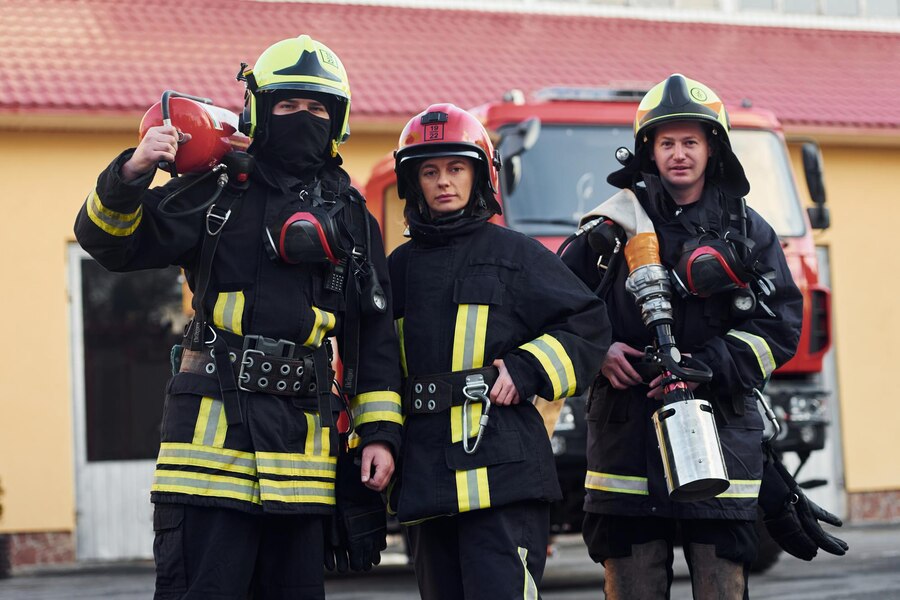Building endurance for firefighter fitness is crucial for success in the demanding world of firefighting. Firefighter fitness isn’t just about strength; it’s equally about sustaining effort over long periods, handling high-stress situations, and recovering quickly from intense physical exertion. As the nature of the job involves handling emergencies where every second counts, high endurance is essential for efficiency and safety.
To excel in firefighter fitness, endurance training must be vital to any fitness regimen. This involves traditional cardiovascular exercises and functional workouts that mimic the physical demands of firefighting. Activities such as stair climbing with weight, interval training, and resistance exercises can build the stamina needed to perform effectively in real-life scenarios. Ultimately, investing time in developing endurance through targeted firefighter fitness routines can significantly improve performance and overall job readiness.
The Importance of Endurance in Firefighter Fitness
Endurance is a cornerstone of firefighter fitness, fundamentally shaping a firefighter’s ability to perform under high-pressure conditions. The nature of firefighting involves prolonged physical exertion, often in extreme environments that demand both physical and mental stamina.
Endurance ensures firefighters can sustain intense activity, such as carrying heavy equipment, climbing stairs, and performing rescue operations without fatigue. A high level of endurance translates to better job performance, increased safety, and a reduced risk of injury.
Additionally, enduring physical strain helps firefighters manage emergencies stress and emotional challenges. Building and maintaining endurance through consistent training enhances overall fitness and ensures firefighters are prepared to tackle the unpredictable demands of their role, ultimately contributing to more effective and safer emergency response.
Essential Endurance Exercises for Firefighter Fitness
Endurance exercises are fundamental to firefighter fitness. They build the stamina and resilience needed for the physically demanding tasks encountered on the job.
- High-Intensity Interval Training (HIIT): Alternating periods of intense exercise with recovery phases boost cardiovascular endurance and overall stamina.
- Stair Climbing with Weights: Mimics the challenge of climbing stairs while carrying equipment, enhancing lower body strength and endurance.
- Sled Pushes: Builds functional strength and endurance by simulating the effort required to move heavy loads during emergencies.
- Battle Ropes: Provides a full-body workout that improves cardiovascular fitness and muscular endurance, replicating the exertion needed in firefighting tasks.
- Tire Flips: Enhances power and endurance by mimicking the lifting and flipping motions required for handling heavy objects.
Integrating these exercises into regular training routines ensures firefighters are well-prepared to handle the physical demands of their profession, ultimately contributing to more effective and safer emergency response.
Designing a Firefighter Fitness Plan Focused on Endurance
Designing a firefighter fitness plan focused on endurance requires a strategic approach that balances cardiovascular conditioning, strength training, and functional movements. Start by assessing current fitness levels and setting specific, measurable endurance goals tailored to firefighting tasks.
Incorporate a mix of aerobic exercises, such as running, swimming, or rowing, to build cardiovascular endurance, alongside high-intensity interval training (HIIT) to improve stamina and recovery. Functional strength exercises, such as carrying heavy loads or performing tire flips, should be included to simulate real-life firefighting scenarios.
Ensure the plan incorporates variety to prevent plateaus and overuse injuries and schedule regular recovery periods to allow the body to adapt and strengthen. Monitoring progress through regular fitness assessments and adjusting the plan based on performance will help optimize endurance and ensure firefighters are well-prepared for the physical demands of their roles.
Nutrition Strategies to Enhance Endurance for Firefighters
Nutrition is vital in enhancing endurance for firefighters, as it directly impacts energy levels, recovery, and overall performance.
- Carbohydrates for Energy: Incorporate complex carbohydrates like whole grains, fruits, and vegetables to provide sustained energy throughout long shifts and training sessions.
- Lean Proteins for Recovery: Include lean proteins such as chicken, fish, and legumes to support muscle repair and recovery after intense physical exertion.
- Healthy Fats for Sustained Fuel: Add healthy fats, such as avocados, nuts, and olive oil, to help maintain energy levels and support overall health.
- Hydration is Key: Ensure adequate hydration by drinking water and electrolyte-rich beverages to prevent dehydration and support optimal physical performance.
- Timing Matters: Plan meals and snacks around training and shifts to provide the necessary energy before workouts and aid recovery afterward.
By adopting these nutrition strategies, firefighters can enhance their endurance and overall fitness, ensuring they are always ready to tackle the demands of their crucial role.
Overcoming Common Endurance Challenges in Firefighter Fitness
Overcoming common endurance challenges in firefighter fitness involves addressing physical and psychological barriers hindering performance. One major challenge is combating fatigue resulting from insufficient recovery or overtraining. Incorporating adequate rest and recovery into training schedules is essential to address this.
Additionally, staying motivated can be difficult, especially when progress seems slow; setting short-term goals and tracking improvements can help maintain focus and drive. Another challenge is balancing intense training with job demands, which requires careful planning and time management to avoid burnout.
Effective strategies include integrating endurance training into daily routines, such as using firefighting drills for practice and seeking support from peers or mentors. By recognizing these challenges and implementing targeted solutions, firefighters can build and maintain the endurance needed for their physically demanding role.
The Role of Mental Toughness in Firefighter Endurance
Mental toughness is a vital component of endurance in firefighter fitness, enabling firefighters to perform effectively under extreme stress and challenging conditions.
- Resilience: The ability to recover quickly from setbacks and continue performing under pressure.
- Focus: Maintaining concentration and clarity of purpose even in high-stress scenarios.
- Positive Self-Talk: Using affirmations and encouraging thoughts to overcome negative emotions and stay motivated.
- Stress Management: Employing techniques such as deep breathing, mindfulness, and relaxation to handle stress effectively.
- Visualization: Mentally rehearsing scenarios and tasks to build confidence and improve performance.
Incorporating mental toughness into training and daily routines is essential for firefighters. It helps them enhance endurance and ensure readiness for the physical and psychological demands of their roles.
Measuring and Tracking Endurance Progress in Firefighter Fitness
Measuring and tracking endurance progress in firefighter fitness is essential for evaluating effectiveness and guiding improvements. Implementing regular fitness assessments, such as timed runs, endurance tests, and strength evaluations, allows firefighters to monitor changes in performance and adjust training accordingly.
Heart rate monitors and fitness trackers can provide real-time cardiovascular endurance and recovery rate data. Maintaining a workout journal or app can also help track exercise routines, intensity levels, and personal progress over time.
Setting specific, measurable goals and comparing current results to previous benchmarks helps identify areas for improvement and motivates continued effort. Regularly reviewing progress ensures that training remains aligned with fitness objectives and allows for timely adjustments. By systematically measuring and tracking endurance, firefighters can achieve more targeted improvements and ensure readiness for the physical demands of their jobs.
Endurance Training for Different Firefighter Specializations
Endurance training must be tailored to the unique demands of various firefighter specializations to ensure optimal performance in specific scenarios.
- Structural Firefighters: Emphasize stair climbing with weighted gear to simulate ascending multi-story buildings while carrying equipment.
- Wildland Firefighters: Focus on long-distance hiking and carrying heavy tools to build stamina for traversing rugged terrain.
- Technical Rescue Teams should incorporate high-intensity interval training (HIIT) and functional strength exercises to handle rescue operations efficiently.
- Hazmat Teams: Develop endurance through simulated scenarios involving heavy protective gear and extended periods in confined spaces.
- Emergency Medical Technicians (EMTs): Combine cardiovascular training with strength exercises to effectively manage high-stress situations and patient transport.
Tailoring endurance training to these specialized needs ensures that each firefighter can handle their specific challenges, enhancing overall effectiveness and safety in their crucial roles.
Integrating Endurance Training into Daily Firefighter Workouts
Integrating endurance training into daily firefighter workouts means combining activities that boost stamina with existing routines. Effective methods include blending high-intensity interval training (HIIT) with strength sessions, using firefighting drills to simulate real scenarios, and adding short bursts of endurance exercises during warm-ups or cool-downs.
Incorporating a mix of aerobic and anaerobic exercises and adequate rest ensures balanced training and prevents burnout. This approach helps firefighters build stamina, enhance overall fitness, and improve job performance efficiently.
Recovery and Injury Prevention for Endurance in Firefighter Fitness
Recovery and injury prevention are crucial for maintaining firefighter endurance and adapting to intense training. Incorporate rest days to allow muscles to repair and use active recovery methods like light exercise, stretching, and foam rolling to reduce soreness and improve flexibility.
Proper hydration and nutrition are essential for replenishing energy and supporting muscle repair. Prevent injuries by warming up thoroughly, using correct techniques, and strengthening supporting muscles. Regularly assess for signs of overuse or imbalance to ensure safe and effective endurance maintenance.
Building and maintaining endurance is essential for firefighter fitness, ensuring that firefighters can perform their demanding roles with resilience and efficiency. At Anne Arundel County Professional Firefighters Local 1563, we understand the critical importance of endurance in this profession.
Whether you’re a firefighter or part of the community interested in supporting our efforts, endurance training is critical to personal safety and overall effectiveness on the job. For more information on enhancing your firefighter fitness or to get involved, call us at 410-987-1180. Let’s work together to ensure that our firefighters are well-prepared and equipped for the challenges they face every day. Your support and commitment significantly impact our ability to serve and protect the community effectively.

